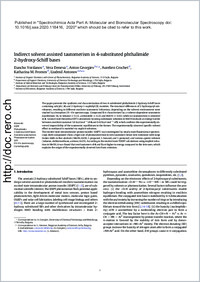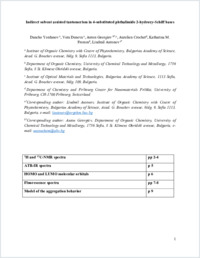Indirect solvent assisted tautomerism in 4-substituted phthalimide 2-hydroxy-Schiff bases
- Yordanov, Dancho Institute of Organic Chemistry with Centre of Phytochemistry, Bulgarian Academy of Sciences, 1113 Sofia, Bulgaria
- Deneva, Vera Institute of Organic Chemistry with Centre of Phytochemistry, Bulgarian Academy of Sciences, 1113 Sofia, Bulgaria
- Georgiev, Anton Department of Organic Chemistry, University of Chemical Technology and Metallurgy, 1756 Sofia, Bulgaria - Institute of Optical Materials and Technologies, Bulgarian Academy of Sciences, 1113 Sofia, Bulgaria
- Crochet, Aurélien Department of Chemistry and Fribourg Center for Nanomaterials FriMat, University of Fribourg, CH-1700 Fribourg, Switzerland
- Fromm, Katharina M. Department of Chemistry and Fribourg Center for Nanomaterials FriMat, University of Fribourg, CH-1700 Fribourg, Switzerland
- Antonova, Liudmil Institute of Electronics, Bulgarian Academy of Sciences, 1784 Sofia, Bulgaria
-
2020
Published in:
- Spectrochimica Acta Part A: Molecular and Biomolecular Spectroscopy. - 2020, vol. 237, p. 118416
English
The paper presents the synthesis and characterization of two 4-substituted phthalimide 2-hydroxy-Schiff bases containing salicylic (4) and 2-hydroxy-1-naphthyl (5) moieties. The structural differences of 2-hydroxyaryl substituents, resulting in different enol/keto tautomeric behaviour, depending on the solvent environment were studied by absorption UV–Vis spectroscopy. Compound 5 is characterized by a solvent-dependent tautomeric equilibrium (KT in toluene = 0.12, acetonitrile = 0.22 and MeOH = 0.63) while no tautomerism is observed in 4. Ground state theoretical DFT calculations by using continuum solvation in MeOH indicate an energy barrier between enol/keto tautomer 5.6 kcal mol−1 of 4 and 0.63 kcal mol−1 of 5, which confirms the experimentally observed impossibility of the tautomeric equilibrium in the former. The experimentally observed specific solvent effect in methanol is modeled via explicit solvation.The excited state intramolecular proton transfer (ESIPT) was investigated by steady state fluorescence spectroscopy. Both compounds show a high rate of photoconversion to keto tautomers hence keto emissions with large Stokes shifts in five alcohols (MeOH, EtOH, 1-propanol, 1-butanol, and 1-pentanol) and various aprotic solvents (toluene, dichlormethane, acetone, AcCN). According to the excited state TDDFT calculations using implicit solvation in MeOH, it was found that enol tautomers of 4 and 5 are higher in energy compared to the keto ones, which explains the origin of the experimentally observed keto form emission.
- Faculty
- Faculté des sciences et de médecine
- Department
- Département de Chimie
- Language
-
- English
- Classification
- Chemistry
- License
- License undefined
- Identifiers
-
- RERO DOC 328550
- DOI 10.1016/j.saa.2020.118416
- DOI 10.5517/ccdc.csd.cc24dgxy
- DOI 10.5517/ccdc.csd.cc24dgyz
- Persistent URL
- https://folia.unifr.ch/unifr/documents/308604
Other files
Statistics
Document views: 93
File downloads:
- fro_isa.pdf: 1447
- fro_isa_sm.pdf: 177

